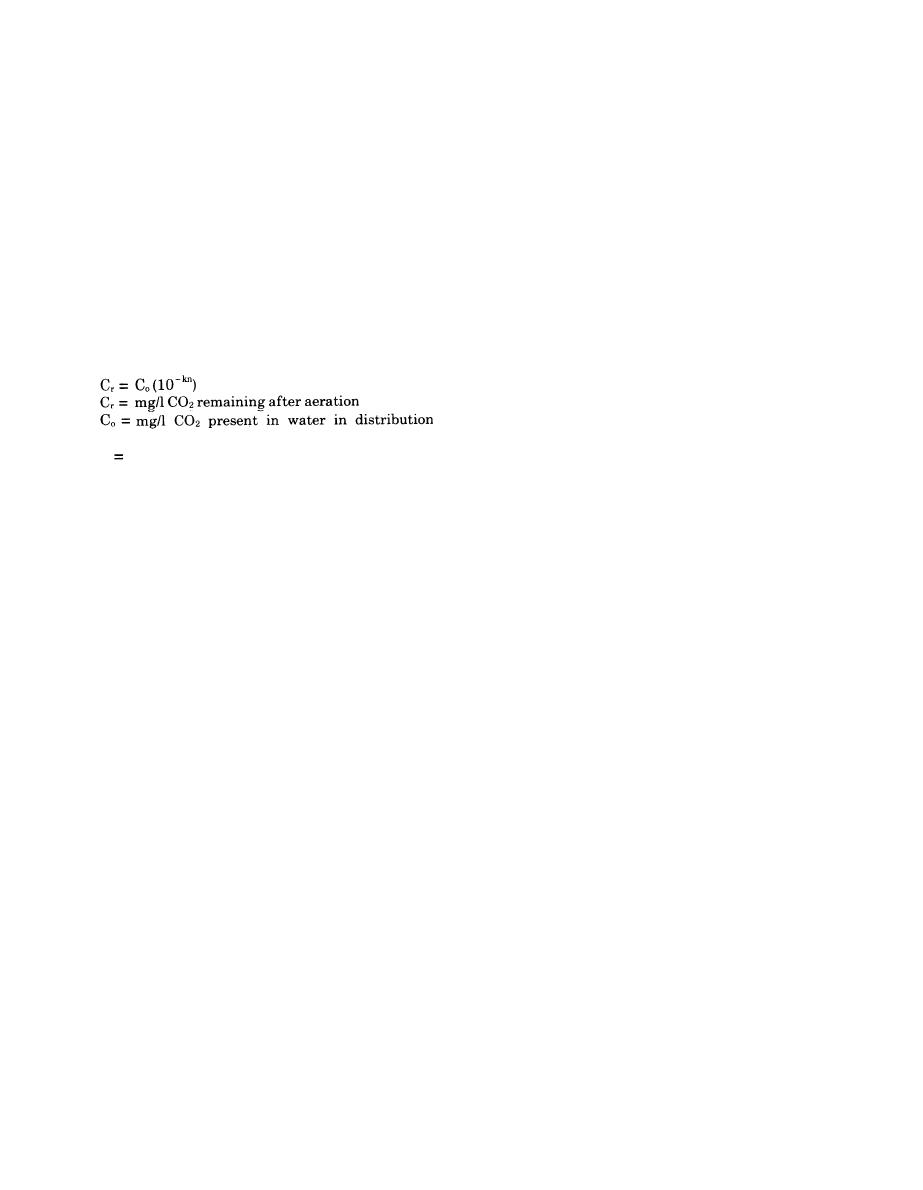
TM 5-813-3/AFM 88-10, Vol 3
literatures and handbooks or AWWA, EPA publica-
ranges from 12 inches to 30 inches. Good distribution
tions.
of the water over the entire area of each tray is essen-
tial. Perforated distributors should be designed to pro-
(2) Diffusion aerators. Compressed air is injected
into the water as it flows through a rectangular basin.
vide a small amount of head, approximately 2 inches
A variety of air injection devices may be employed in-
on all holes, in order to insure uniform flow. In aera-
cluding perforated pipes, porous plates or tubes and
tors with no provision for forced ventilation, the trays
various patented sparger devices. Basin size is deter-
are usually filled with 2- to 6-inch media, such as coke,
mined by desired detention time, which commonly
stone, or ceramic balls to improve water distribution
ranges from 10 to 30 minutes. Tank depth is usually
and gas transfer and to take advantage of the catalytic
from 10 to 15 feet. Air requirements, supplied by a
oxidation effect of manganese oxide deposits in the
compressor, generally range from 0.1 to 0.2 standard
media. The water loading on aerator trays should be in
cubic foot per gallon of water aerated. Major advan-
the range of 10 to 20 gpm per square foot. Good, nat-
tages of a diffusion aeration system include practically
ural ventilation is a requirement for high efficiency.
no head loss and freedom from cold-weather operating
For multiple tray aerators designed for natural venti-
problems. An additional advantage is that a diffusion
lation, the following empirical equation can be used to
aerator may also be used to provide chemical mixing.
estimate carbon dioxide (CO2) removal:
Power requirements are those associated with air com-
pression and range from 1.0 to 2.0 kilowatts per mgd
of aerator capacity. Aeration efficiency in terms of ad-
tray
dition of oxygen or removal of carbon dioxide is gen-
n number of trays, including distribution tray
erally similar to that provided by multiple-tray aera-
k = 0.11 to 0.16 depending on temperature, tur-
tors employing natural ventilation.
(3) Mechanical aerators. Mechanical aerators typi-
bulence, ventilation, etc.
Where icing is a problem and the aerator must be
cally consist of an open impellar operating on the wa-
housed, artificial ventilation by fans or blowers is nec-
ters surface. Basin size is determined by detention
time required. Basin depth can vary from 5 to 17 feet
essary. An enclosed induced- or positive-draft aerator
with the average depth being 10 feet. Major advan-
requires approximately 3.5 to 6 standard cubic feet of
ventilating air per gallon of water aerated. Thus, for
tages of mechanical aerators are practically no head
loss and the ability to provide mixing. Mechanical
an enclosed aerator operating at a rate of 1.5 million
aerators are generally not as efficient as aeration tow-
gallons per day (mgd), air requirements will be in the
range of 3600 to 6200 standard cubic feet of air per
ers or diffused aerators and longer detention times are
required.
minute. Positive-draft aerators employing the higher
d. Criteria for installation of aerators. Aeration is a
air-flow rates exhibit the highest efficiency for the ad-
dition and removal of dissolved gases and oxidation of
gas transfer process which is not needed at all water
iron, manganese, and sulfide. Power requirements for
treatment plants. A decision as to whether to aerate or
not requires assessment of the economic and water
a natural draft, multiple-tray aerator having an overall
height of 10 feet will be approximately 1.7 kilowatts
quality benefits achieved by its use.
(1) Addition of oxygen. Aeration processes are
per mgd of aeration capacity. Power demands for
commonly used in adding oxygen to groundwaters and
forced draft units will be greater.
(b) Counter-current packed column aeration. A
to oxidize iron, manganese, hydrogen sulfide and to a
counter-current parked column aerator tower is simi-
limited extent, organic matter. Groundwaters are
usually deficient in oxygen and acration is an effective
lar to operation to counter-current multiple tray aera-
means of adding it. Oxygen addition is normally re-
tors, but are particularly efficient at the removal of
quired if iron and manganese removal is a treatment
volatile organic compounds (VOCs) through air-strip-
objective. Aeration will also help oxidize hydrogen sul-
ping. Packed column aerators consist typically of a
fide and some organic matter.
long thin tower filled with either a random dumped
media (Rasching rings, Ber) saddles, Pall rings) or cor-
(2) Partial removal of volatile substances. Aera-
rugated sheet media, held by a packing support plate.
tion is a useful method of removing volatile substances
Water is pumped to the top of the tower over a distri-
from water. Groundwaters while being deficient in
bution plate and allowed to fall through the media. Air
oxygen can contain objectionable levels of carbon diox-
is blown up through the tower by a fan counter to the
ide. An efficient aerator will result in near saturation
falling water. Redistributor plates are used through-
with oxygen and about 90 percent reduction of the car-
out the column to prevent channeling of the water or
bon dioxide content of groundwater. At lime-soda wa-
air stream. Efficiency of the tower is dependent on the
ter softening plants, any carbon dioxide dissolved in
extent of contact between the air and water. Detailed
the water at the point of lime application will consume
design can be found in various chemical engineering
lime without accompanying softening. For high (>50
2-3


 Previous Page
Previous Page
